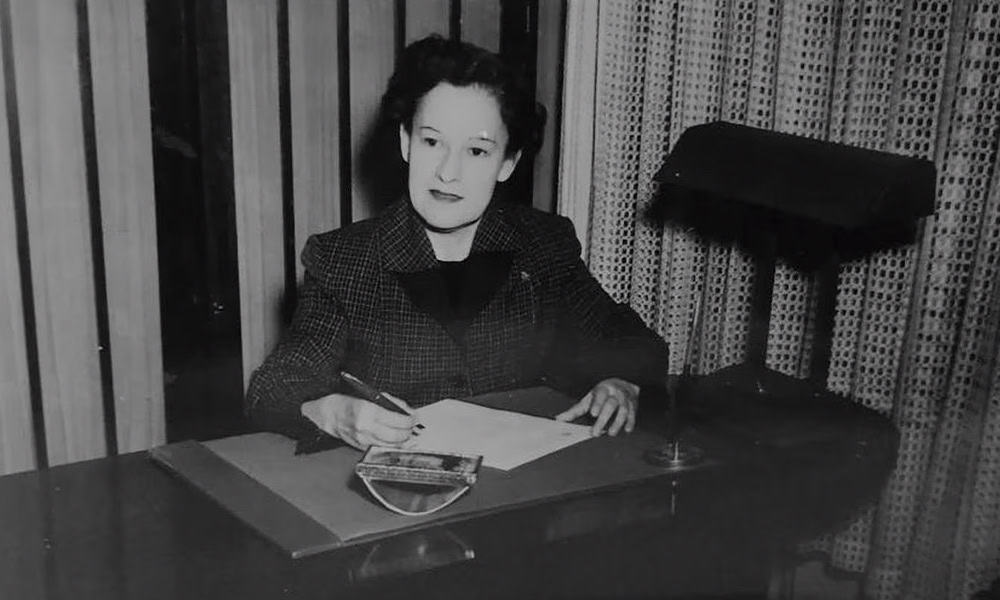With the world set to celebrate International Women’s Day tomorrow, it’s only fitting to introduce you to one of Costa Rica’s most notable. Non-Ticos may not know who Emma Gamboa was, but her face is familiar to all – that’s her on the ¢10,000 bill. Gamboa was one of those people who stand out and make history, and in her field, education, she had an impressive list of “firsts.”
She was born Oct. 17, 1901, in the western Central Valley coffee town of San Ramón de Alajuela, far from the urban metropolitan area and at a time when women’s rights were still in the future. Even so, many women, even in San Ramón, managed to break the mold society set for them.
Gamboa’s mother, María Alvarado, had a hat factory that made hats for men and women, a good business when hats were a fashion must. An independent woman, she encouraged her three daughters to study as well as her three sons. All six went on to college.
After high school, Gamboa followed her older siblings to the former Escuela Normal, a training college for schoolteachers in Heredia, north of the capital, graduating in 1920.
As a primary school teacher, she was well liked and respected because she believed in a philosophy of education that concerned the whole child, including character formation. Ana Isabel Gamboa, niece of Emma and a psychologist from Heredia, has her aunt’s notebooks from those early years, in which she wrote out her “rules” for students.
“To become good Central American citizens one must practice self-control. ‘I will be the owner of my tongue and will not permit a vulgar or profane word. I will be the owner of my character and not allow anger when people or things go against me. I will be the owner of my thoughts and will never yield to wrong desires or desist from good intentions,’” she taught.
These rules were also imparted to student teachers. When the University of Costa Rica (UCR) started a department of education in the 1950s, Gamboa was one of its first professors. In 1957 she started the university’s laboratory school for students to practice teaching and observe how young children learn.
Ana Isabel Gamboa recalls family stories about her aunt. Young Emma hadn’t started school yet but she trailed after her older sisters when they went to catechism classes, where she quickly learned all the prayers and responses. Disappointed at having to wait until she was 9 to make her first Communion, she begged the priest to review her prayers and catechism responses.
When he realized she was one of his brightest students, he let her make her first Communion at the tender age of 5. That was perhaps her first “first.”
Ana Isabel remembered how her aunt enjoyed the children in her family and encouraged them to learn. “She asked us to tell stories, which she wrote out for us,” she said.
Seeing that the readers used in primary schools came from other countries and did not use Tico words, she wrote the book “Paco y Lola,” which was used to teach phonetic reading with a Costa Rican vocabulary. In recent years, the book lost favor because the text reflects gender roles from the past, but millions of children here learned to read with “Mamá amasa la masa” (“Mother kneads the dough”). Ana Isabel said she and family members want to revise and update the book.
Gamboa published many articles on education, and she was also a leading advocate for women’s rights in the 1930s and ’40s, before women had the right to vote. She campaigned for suffrage and urged other women, mothers of students and colleagues, to join the marches and demonstrations for the vote.
On Aug. 2, 1947, Gamboa was among the leaders of the 8,000 women who marched on the presidential home, then situated in downtown San José, west of Morazán Park and across from the National Culture Center (CENAC). That night the women decided to stay in the Central Park until the government gave in on the right to vote, but around 11 p.m. the lights were cut off and police fired into the air, causing panic.Voting rights were granted in 1948 by the provisional government following the civil war.
Around that time, Gamboa held another important position as the president of the National Association of Educators (ANDE). In 1947 she was chosen as the first woman to head the group.
Though Gamboa had no political ambition and played no part in political parties, she was appointed minister of education during the administration of Otilio Ulate in 1950, making her the first woman to hold a ministerial position in Latin America. Her influence on education spread across borders to neighboring countries. Her interest in philosophy inspired her to travel to many countries to study, and in the 1950s she visited India, then a difficult journey for a woman alone.
Like most women of her time, Gamboa did not marry while she held a career, but in 1965, at the age of 64, she married Wade Bower of the U.S. state of Ohio, the widower of a longtime friend. They made their home in Heredia, and Ana Isabel remembers that they enjoyed their garden full of tulips.
Gamboa died of cancer at the age of 70 in September 1972. Posthumously she earned another distinction when her picture was chosen for the ¢10,000 bill. She was the first woman in the Americas to be so honored.







